Technology of use
There are no special requirements for applying moisture and decay impregnation for wood. All this is similar to applying paint or varnish, so you can easily cope with this process with your own hands.

There are several guidelines:
- processing is best done in dry and warm weather;
- impregnation should be applied to the cleaned surface;
- brushes and rollers are used as tools, if the treatment area is large, then liquid compositions on wood can be sprayed with a spray gun;
- if work is carried out on the street using toxic drugs, then you must wear personal protective equipment: gloves, glasses, a respirator;
- pay attention to the consumption of antiseptics, which the manufacturer indicates on the label, do not exceed it, because a lot of applied layers does not mean an increase in their protective properties;
- read the rules for using impregnations for wood, which the manufacturer indicates on the label, strictly follow them.
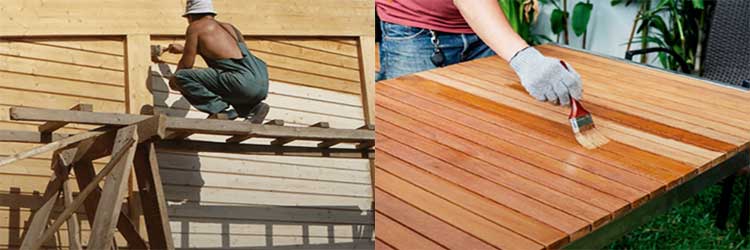
There are some lumber structures that are constantly exposed to moisture. These are cellars located in the ground. Here, the structure must be processed both outside and inside. External treatment includes full coverage with moisture-proof antiseptic, plus good waterproofing in the form of bitumen mastic or hot bitumen.
From the inside, only treatment with antiseptic compounds is often carried out. Better oil-based, because it is always humid inside the cellar. The main thing is to provide the room with good ventilation.
How to deal with decay
Measures to protect wood from decay are taken in two directions:
- Taking measures to reduce moisture and protect lumber from getting wet,
- Prevention of fungal diseases by using various methods of wood processing.
Dry wood is less susceptible to decay; when building a house from a turnkey kiln-dried profiled bar, it is important to preserve the initial moisture content of the material. In shrinkage construction, the material reaches its optimum importance after 1.0-1.5 years
In this case, measures to prevent the development of fungus include:
- Waterproofing that protects the frame from soil moisture,
- Shelter of a log house with a permanent or temporary roof,
- Ensuring ventilation of the building in order to uniform evaporation of moisture, windows and doors are not installed,
- Primary treatment of walls with available antiseptics.
The following are used as antiseptics to prevent decay at the stage of log shrinkage: solutions of silicate glue, copper and ferrous sulfate, 20% saline solution with the addition of 1% boric acid, walls can be treated with chlorine bleach "Whiteness". It is necessary to treat the walls with a temporary antiseptic in the warm season; in winter, fungal spores do not show activity.

After the completion of the drying process, the walls are sanded, this operation has two goals: it gives the structure an attractive appearance and removes the surface layer, which is most likely infected with fungal spores. The treated surface is cleaned and a finishing layer of antiseptic is applied. There is a wide selection of professional antiseptics on the market, designed for different climatic zones and allowing to process wood of various species. Correctly and in a timely manner to process the blockhouse means getting rid of problems with replacing rotten parts.
Siding, facing bricks, decorative tiles are used to protect the wood structure from the accumulation of capillary moisture. An effective method of protecting wood from moisture is acrylic and alkyd paint; walls can be treated with these paints without a primer.
How to process a wooden fence
For the protective treatment of wooden fences, you can use an improvised folk remedy or pick up a ready-made factory antiseptic solution.Commercially available impregnating compositions are often combined and contain moisture-repelling agents, fire retardants for fire protection, and herbicides for protecting against fungi and insects.
Folk ways
Wood, as a building material, has been used for many centuries, our ancestors knew well how to make an impregnation to protect a tree. Fence wood can be treated with solutions that are easy to prepare at home.
- Universal impregnation - processing of the board with tar from birch bark or resin of coniferous species above ground level.
- Heated used engine oil will protect lumber from rotting. Several layers are applied.
- Application of melted bitumen or tar on a pre-fired layer.
- Protection from moisture and decay - 1% solution of iron or copper sulfate.
- "Finnish recipe" for a solution consisting of flour, ferrous sulfate, salt and lime, diluted with high temperature water. Such a preparation, applied in two layers, is an effective protection of the fence from decay.
- By coating the mounted fence with wood glue, you can protect the tree from moisture.
- Parts of the fence that go into the ground can be treated with a solution of potassium dichromate with sulfuric acid in a one-to-one ratio.
- Using a spray bottle, a solution of vinegar and soda is applied.
- It is possible to apply a solution of boric acid, salt and water. One part of boric acid and 20 parts of salt are added to 10 liters of water.

Homemade protection solutions are suitable for use on new, non-destructive structures.
Ready-made solutions
Antiseptic solutions available on the construction market are made from chemical constituents, many of which are quite toxic. Their variety is great and, in order to choose a suitable impregnation, you need to have an idea of the main types and properties. The most dangerous for humans are compounds containing tin and zinc.
Water based impregnation
Such a composition is safe and dries quickly. It can be used to combat fungus and prevent rotting. Such impregnation will protect poorly from moisture - it dissolves easily.
Oil based product
This impregnation is well suited for exterior work. A film is formed on the wood surface treated with such a means, which protects against the ingress of fungus and moisture. This impregnation cannot protect a tree infected with mold.
Volatile agent
Such a composition, in addition to the dye, contains an easily volatile substance. These agents do not penetrate deeply into the material, but the strength of the film that is created on the surface has good protective qualities. Such impregnation is recommended for use in outdoor works, its drying time is longer than that of analogues.
Decorative impregnation
This moisture resistant impregnation penetrates deep into the wood structure, displaces moisture and prevents its further spread. In addition, it adds brightness to the product, emphasizing the noble natural shade. This tool is not cheap, and its penetration into the fibers takes a long time.
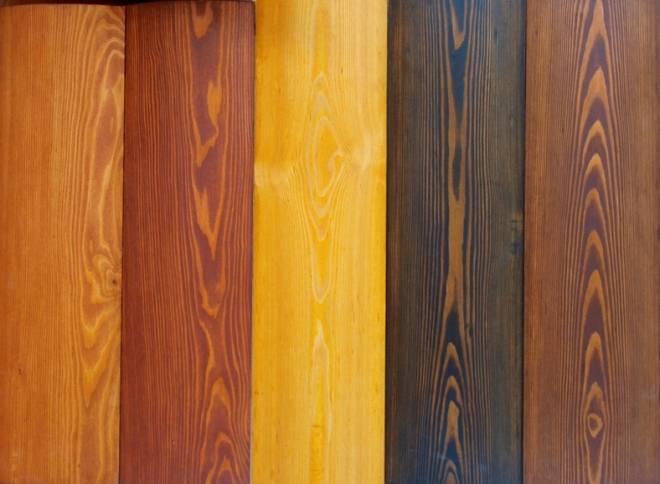
Fence painting as a method of protection
The traditional way to protect fences from destruction is painting. Wooden surfaces are usually painted in two layers - a primer is first applied, and then a paint and varnish material. Instead of coloring agents, new hedges can be varnished to create a water-repellent film without obscuring the natural texture of the wood. Before painting, the surface must be cleaned of dirt, old paint layers and sanded. Work is best done in dry warm weather. Sunlight can damage the primer and paint during the drying period.
Basic tools to combat rot
The industry offers consumers several varieties of wood decay products. When choosing one or another option, consider the main type of impact:
- to protect against rain, snow, moisture from the soil of gazebos, pergolas, verandas and terraces, it is better to choose special paints and varnishes;
- from the appearance of condensate and its destructive effect will be protected by vapor and waterproofing membranes and films. The variant is ideal for saunas, bathrooms, rooms with constant high humidity;
- high-quality drying will help to remove excess moisture from any source, but without artificial heating.
It is important to emphasize that the effect will be very short-lived.
Antiseptics are suitable for use, regardless of the cause of mold and mildew. Recommended for use both at the stage of construction and design, and during operation, when the fungus has already appeared, and they need to be preserved.
When choosing an antiseptic, it is important to consider whether it is intended for outdoor or indoor work. It's not only about the number of working components, but also about the toxicity of the composition.
Varnishes and paints. They not only protect wooden products from mold formation, but also give an attractive appearance, emphasize the structure of the material. The disadvantage is the high price and long processing time, taking into account drying and the need to apply several layers.
Processing sequence
For novice home craftsmen, the question sometimes arises: first you need to erect a fence, and then treat it with chemicals and paint, or all this should be done with wooden parts before assembling them. There is no definite answer here. The first option is good because it is convenient to cover the assembled structure with protective materials and paint. The advantages of the second option: the fence will not have untreated stains in hard-to-reach places and joints. Caring for the wood material begins from the day it is purchased.
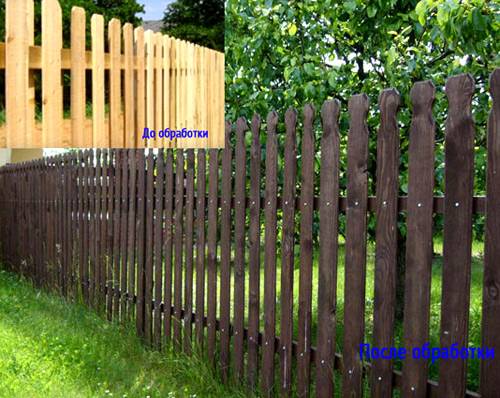
The sequence is as follows:
- Remove bark from non-edged boards, wooden posts. It can contribute to the development of wood grinders and mildew.
- Stitch the veins of the boards. With this treatment, the pores are closed, and the wood will last longer.
- Saturate with hot tar and wrap with roofing material that part of the pillars that will need to be buried in the ground, where the effect of moisture is great.
- To exclude the process of decay, more thoroughly process the lower ends of the boards, especially if their contact with the ground is expected.
For wood processing, an antiseptic is used in two stages. The first impregnation is carried out after the completion of the installation of the fence, and after a while it is repeated. This should be done very carefully, remembering that this material is very toxic.
Methods for protecting wood from fungi and insects
Let's consider different methods of protection. Both preventive measures are taken to protect healthy wood, as well as the treatment of materials already affected by fungi or insects in order to destroy foci of damage and prevent their spread. Wood can be protected by physical, mechanical and chemical methods. Let us dwell on the latter in more detail.
- Antiseptic treatment of wood surface - application of a protective agent to the surface of the material, not designed for deep penetration.
- Wood preservation - processing with deep penetration of the protective agent.
- Fumigation of wood - treatment with protective gases against wood-destroying insects.
- Sterilization of wood - treatment of wood with chemical or physical means in order to destroy biological agents of destruction.
- Fire protection of wood - treatment with compounds that reduce the material's ability to ignite. These can be impregnating compounds (fire retardants) or fire retardant coatings (create a protective layer on the surface) coatings, paints, varnishes, enamels, etc.
Why and from what it is necessary to protect natural wood
The tree is susceptible to the destructive effects of the environment. These are humidity, sudden changes in temperature, various types of mold and pests, direct exposure to ultraviolet rays, wood and fire are afraid. In order for the created barrier to please the eye longer, it must be timely and correctly treated with special substances. Impregnation of natural wood from moisture, decay and other destructive external factors will significantly extend the life of the fence.
Moisture protection
The erected hedge during operation, being in conditions of high humidity, begins to collapse and lose its visual appeal. This is due to the following factors:
- moisture remaining in the material can cause rotting;
- external influence of atmospheric phenomena in the form of precipitation, dew, fog negatively affects the quality of lumber;
- Moisture trapped inside during the freezing process leads to cracks.
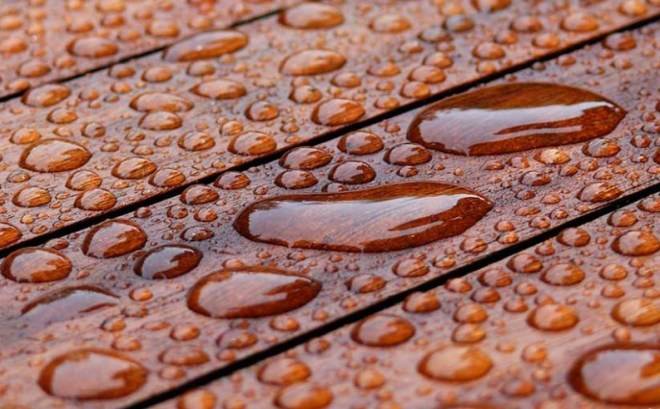
To protect the board from dampness, the material must be prepared and processed even before installation. It is advisable to stitch the dried boards, this will close the pores on the surface of the wood, and this will reduce the possibility of moisture getting inside the fibers.
How to treat wood and boards from decay
The next stage in the preparation of the material is the choice of impregnation to protect it from decay. The point of applying such mixtures is that it penetrates into the pores of the tree and prevents moisture from entering there, thereby protecting the boards from decay. A variety of antiseptic impregnations are available on the construction market, which are used to protect a wooden fence.
The processing of the board can be done with various compositions that can be prepared at home. Many impregnate wood with a solution of copper or iron sulfate. For impregnation, the tree must be kept in a bath with a solution for at least a day so that it does not rot later. Another cheap way to treat boards is to soak them with heated used machine oil.
Fire retardant wood treatment
Wood is a flammable material, so attention should be paid to protecting the fence from fire. This is especially true for those sections of fences that are in close proximity to open sources of fire and buildings belonging to the category of increased fire hazard - various barbecues and bath rooms

To protect against fire, the material is treated with fire retardants, many of which also contain an antiseptic. Some types of fire retardants penetrate deep into the wood fibers, but to use them, the material must be kept in baths with a solution. Most often, chemicals are used, which are applied to the outer layer with a spray or brush. Such substances create a protective film on the wood surface. The action of the latter, due to the external influence of the environment, is less durable.
The better to treat wood from fungi, mold, parasites
The tree is a natural habitat for many types of fungal microorganisms and bark beetles.
Fungi have different effects on wood. Plant species of fungus (blue and mold) do not destroy wood, but spoil its aesthetic component, they form spots of blue, gray and white on the surface. The putrefactive fungus penetrates into the material and at the final stage completely destroys it, turning it into dust. The development of this species may be evidenced by the appearance of rust colored spots on the surface.
Bark beetles destroy the structure of the trunk of the wood, eating through the passages under the bark. You can protect the hedge from them by timely freeing the material from the bark.
For the development of microcommunities of plants and insects in wood, an appropriate environment is needed. First of all, it is the presence of moisture.The above methods of protecting wood from moisture prevent the development of fungi and bark beetles in it. For best results, the material is impregnated with a durable liquid glassine solution. This solution is suitable for use in humid environments. It contains antiseptic and herbicides. The solution penetrates into the pores of the material, displacing moisture from there. There it polymerizes - plugs are formed, which clog the holes and prevent moisture and air from entering there. Glassine is not afraid of bad weather - it can be applied in any humidity conditions. Processing wood with turpentine or tar will also protect the fence from moisture and pests for a long time.
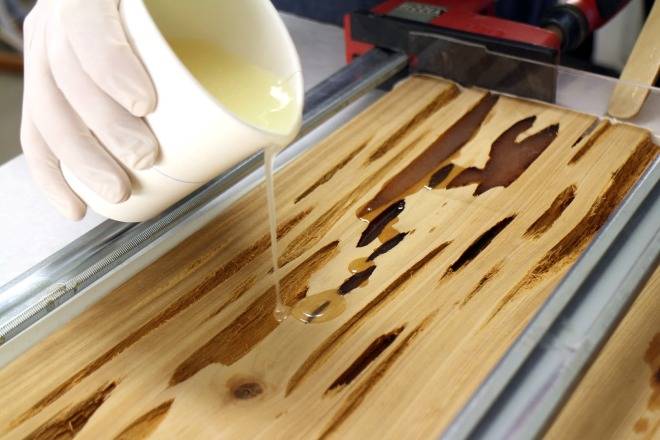
Wood impregnation methods
The methods of wood impregnation are selected depending on the purpose of the impregnated material, the conditions of its service and the type of protective composition.
- When a preservative is applied to the wood surface with a brush or spray, a thin protective layer is created on the wood surface. The range of retention of protective agents by the surface of the material depends on the viscosity, surface activity of the impregnating liquid, density, moisture, and roughness of the wood surface.
- Immersion (soaking). This method consists in the fact that the material is immersed in a container (impregnating bath) with a cold or hot antiseptic solution. Such impregnation is the simplest in production conditions and on construction sites. The average penetration depth of the composition is 2–3 mm.
- The warm-up cold bath impregnation method (CWB), also known as the hot-cold bath method, is widely used for impregnation of building parts and structures with antiseptics and fire retardants.
When impregnating wood with the PRHV method, a vacuum is used, which is formed as a result of a sharp temperature drop in the wood, first heated in a hot liquid, and then quickly cooled in a cold one. When heated, the air in the outer layers of the wood increases in volume, and part of it is removed. Moisture evaporates at the same time. When immersed in a cold liquid, the volume of the cooled vapor-air mixture decreases, and a vacuum is formed in the outer layers of the wood. The antiseptic penetrates the wood under the influence of atmospheric pressure and impregnates it.
- A method of impregnating wood under atmospheric pressure with preliminary evacuation. Based on the introduction of an impregnating liquid under the influence of atmospheric pressure, increased in relation to the pressure inside the wood. The material is loaded into an impregnating container and a vacuum is created in it, then the container is filled with an impregnating liquid, the vacuum is removed and the wood is kept at atmospheric pressure. The total cycle time is about 1 hour.
- Vacuum - pressure - vacuum impregnation (autoclave) consists of the following three operations. The material to be processed is placed in an autoclave, where a vacuum is created - all the air is pumped out of the wood. Under the influence of vacuum, a protective compound enters the treatment chamber from the reservoir. By means of hydraulic pressure, the impregnating solution is pumped into the prepared wood cells. The time to maintain the hydraulic pressure directly depends on the type of wood being processed. After deep impregnation of the wood, the protective agent is pumped back into the tank. A vacuum is again formed in the chamber, with the help of which the residues of the impregnating composition are removed from the surface of the treated wood. The final vacuum when impregnated with oils serves to reduce the initial absorption, and when impregnated with water-soluble antiseptics - to dry the surface of the material.
After that, the pressure in the chamber is restored to atmospheric.At the end of the process, the wood must be allowed to mature for a certain time in order for the preservative antiseptic to fix.
When using this method, it is desirable that the processed material is well dried, since the high moisture content can prevent the penetration of the protective composition into the wood cells. It is believed that the pre-impregnation moisture content of wood with this method of impregnation should not exceed 30%.
The above technologies are applicable at the production stage or to protect the finished structure, which is not yet deeply damaged by fungi and insects. However, manufacturers of building materials or builders do not always take the trouble to treat wood with protective agents.
Wood processing technology
Wood processing can be carried out in various ways.
When preparing material for construction, processing is usually carried out by immersion in a solution. This method requires special equipment.
If the material was laid without treatment, then you can use the spraying method, which also protects against rotting, but has a small penetration depth. This method works well for temporary protection.
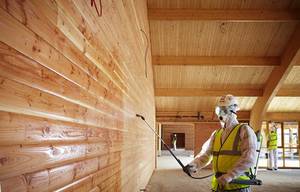
- first you need to clean the wood from dirt and dust;
- use sandpaper to get rid of gaps;
- wash the boards with warm water with any detergent;
- dry the boards completely;
- apply the protective agent as many times as indicated in the instructions.
During processing, it is important to handle the substance with care, ensuring your own safety. The product should not come into contact with skin, eyes, in case of contact, immediately wash off the chemical with water. Respiratory safety must be ensured when using the spray method
Respiratory safety must be ensured when using the spray method.
Today, there are many means and preparations that prevent wood from rotting, so you can build a house or other wooden objects without fear that they may soon collapse. And most importantly, do not forget to comply with all necessary safety measures.
Use of wood preservatives
If we give a comparative description of varnishes and antiseptics, then the use of the latter is more profitable financially. In addition, varnishes and paints do not remove existing stains, but only preserve them. Antiseptic compounds eliminate those that already exist and prevent the appearance of new ones.
How to choose treatment products
The antiseptic market is filled with products from both foreign and domestic manufacturers. The former are more expensive, but they do not always guarantee quality. Which composition to choose is decided only by the buyer, based on his own preferences, characteristics of the drug and financial capabilities.
In Russia, you should pay attention to Sarus products. It not only gets rid of existing rot, but also prevents new colonies of the fungus from appearing.
If rot covers a significant part of the surface, you should pay attention to the drug Neomid 500. The good power of the drug is "compensated" by the high price.
Among the cheaper analogues with the same characteristics, the drug Liga Bioshchit stands out.
For the treatment of very rotten areas, water-based Senezh products are used, which penetrate deeply into the structure of the tree. They are recommended for both primary and reprocessing, and for working in damp, cool places such as cellars. The only exception is that surfaces should not be painted with oil paint. When choosing a drug from a series, consider the specific task.
The drug Drevosan Profi will help prevent the development of putrefactive processes. Recommended for processing fences, window frames, small architectural forms. An additional advantage is the death not only of mold and rot, but also of insects that destroy the wood from the inside.
Do you want to save money, buy one drug for both outdoor and indoor work? Spend money on the Bicidol-100 antiseptic
An important advantage is that the composition not only forms a protective film on the surface, but also penetrates the wood structure without changing it. During the entire service life, the tree will be under reliable protection from both water and fire.
If you want to avoid this, pay attention to the modification of the Bicidol-500 preparation. Preservation of the original color is guaranteed.
You should choose a treatment tool only after a thorough study of the technical characteristics, composition, principle of action and side effects. The method of application is no less important - with a brush, a spray gun. Some formulations provide that the product must be completely dipped in the solution.
If you do not follow the manufacturer's recommendations, you will have to change the affected or damaged parts of the interior or facade.
The duration of the drugs
The combination of constant humidity and high temperatures creates favorable conditions for the appearance and development of rot. A high-quality drug will delay this moment for 12 years or more. Antiseptics protect against fungus and fire. The maximum validity period is no more than 7 years. For the treatment of buildings, design elements, fence posts, formulations that are resistant to water are intended. Then, for 30 years or more, you will not have to worry about repair or replacement. Ideally, the preparation contains components that protect against cracking.
Don't buy random funds. Read the manufacturer's instructions, consumer reviews. Careful selection is a guarantee of getting rid of mold and rot. To enhance the effect of any drug will help preliminary cleaning from existing stains of rot, dirt, paint or varnish.
Means and preparations for wood processing
It is advisable to carry out measures to prevent rotting from the moment of harvesting materials for construction.
Rotting wood reduces its density, gradually leading to loosening and destruction of the structure, which is very dangerous for human life and health, therefore, it is imperative to carry out processing.
Wood decay can be prevented by thoroughly examining the entire surface of a wooden building once a year. Rotting in infected areas will be indicated by an unpleasant odor and a white film.
Signs of wood decay are the characteristic rotten smell and a white, thin film in places infected with rot and mold spores.
Depending on the source causing the decay process of the tree, measures to prevent it will depend.
- For example, vapor and thermal insulation protects wood species from condensation.
- Protection from atmospheric humidity will be provided by special paints and varnishes.
- Drying naturally with sunlight will also get rid of excess moisture.
- The most common and effective methods are conservation methods and the use of an antiseptic. The principle of operation of these methods lies in the poisonous effect of the drug on the causative agents of putrefaction.
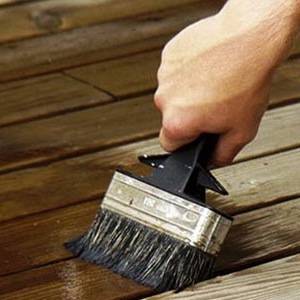
The use of antiseptic agents is advisable already at the stage of the appearance of mold. When choosing a product, you must carefully read the instructions, since some drugs are suitable only for internal processing, for example, inside the house, and some are exclusively for external processing.
For example, combined antiseptics are only suitable for external treatment, as they are toxic.
If we compare funds for wood decay in cost, then it should be said that paints and varnishes are more expensive than antiseptics, and in order to prevent decay, you need to purchase a considerable amount of paint. So the use of an antiseptic is much more beneficial both from a practical and an economic point of view.
How to prevent rotting
The development of molds is the main factor that destroys wood. The development of mold (decay) occurs under certain conditions:
- air humidity 80–100%;
- moisture content of the material is higher than 15%;
- temperature below 50 and above 0 С
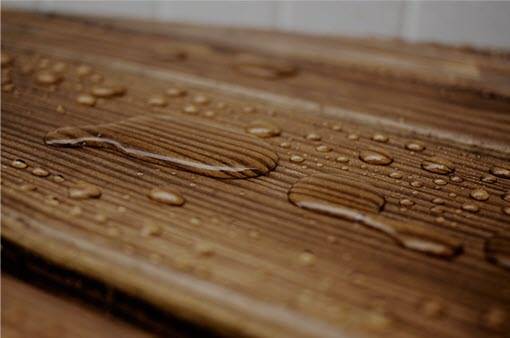
Factors favorable for the decay process are quite common. Therefore, you need to know how to process wood in order to protect it from mold.
Trees growing in nature have reliable protection in the form of their own tree bark. During the construction of buildings or the manufacture of various products from wood, the bark is removed, which entails a violation of the wood structure under the negative influence of the external environment. If the structures do not have moisture and decay impregnation for wood, then they are destroyed due to the following factors:
- Fungi and mold - often infects wood in conditions of humidity and limited air access. The tree serves as an excellent breeding ground for harmful microorganisms, especially if it is saturated with moisture.
- Insects - the most common enemies of the tree are the weevil beetle, bark beetle, woodworm, which can not only harm the wood, but also completely destroy it. Small holes and grooves visible on the wooden surface are characteristic signs of the appearance of insects.
- Moisture - rains, fogs, melting snow, and simply high humidity inside the room lead to swelling of the wood and the formation of cracks, and also favor the appearance of rot. Impregnation for wood against moisture reduces the water absorption of the material, without affecting its ability to "breathe".
As additional factors that negatively affect wood, it is worth mentioning ultraviolet rays, which destroy the natural substance lignin, which is responsible for the hardness and rigidity of wood. Under the influence of the sun, wooden products become softer, lose their natural color and crack.
To reduce the likelihood of the development of putrefactive processes to a minimum, at the construction stage they provide:
- high foundation;
- waterproofing;
- good ventilation;
- moisture resistant roof.
How to choose the right product?
When choosing a protective device, it is necessary to take into account the individual characteristics of the object, its location, and the purpose of its construction.
For example, if the object is located in the coastal zone or in the room itself, a high level of humidity is constantly maintained, then it is necessary to select a tool that will protect the wood in case of temperature extremes. Such funds last up to 12 years on average.
It should also be borne in mind that often the properties of the drug are designed not only to prevent rotting, but also to protect the wood from ignition. The term of such "multifunctional" funds is up to 7 years.
It is better to treat terraces or gazebos with hard-to-wash products, one treatment is usually enough for 35 years.

It is often not necessary to process wood, but the first warning sign that requires additional processing is the appearance of cracks on the surface. Modern manufacturers offer a number of impregnations that prevent the destruction of wood. For example, "Wood Doctor", "Elkon", "Biox" help to get rid of mold and mildew, and are also suitable for interior and exterior processing. These brands are made in Russia.Of the highest quality preparations of foreign manufacturers, one can name the Dulux company, which is famous for a large selection of impregnations against fungus, and the Alcator products penetrate deep into the wood and dry quickly, and the treated wood serves for a very long time.
